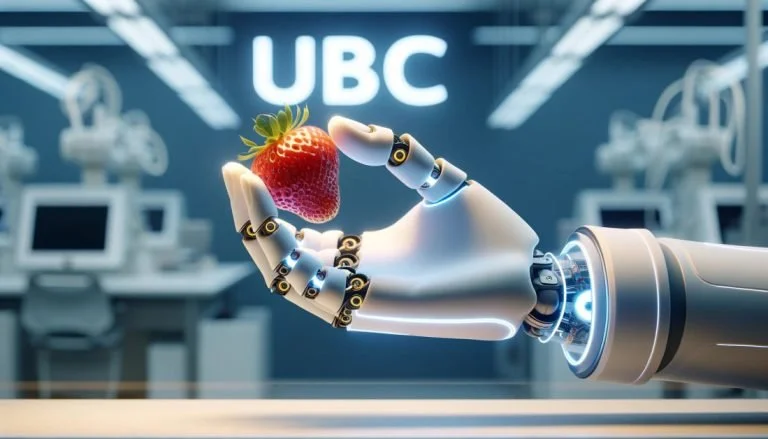Researchers at the University of British Columbia (UBC), in collaboration with Honda, have pioneered a smart, stretchable and remarkably sensitive soft sensor in a breakthrough development that promises to reshape the world of robotics and prosthetics.
This advanced technology will unlock countless applications, heralding a new era in which robots and prosthetic devices not only move but also feel, enhancing their interactions with the world and people.
The combination of sensitivity and durability in the new sensor mimics the touch of human skin, giving machines the unprecedented ability to perform tasks that require delicate touch, such as processing soft fruit without damaging it.
The implications of this advancement are vast and diverse, from improved safety in human-robot interactions to improved functionality in automated tasks.
The development of the sensor, Dr. It is a testament to the creativity and forward-thinking approach of the UBC team, guided by Mirza Saquib Sarwar’s innovative research in electrical and computer engineering.
However, Honda’s Frontier Robotics brings a storied history of robotics innovation to the table, making collaboration a powerhouse of technological synergy.
As the world stands on the cusp of this robotic renaissance, the introduction of the soft sensor marks an important milestone in our journey to create machines that not only mimic human actions but also have human sensitivity.
This breakthrough is a sign of the extraordinary achievements we can achieve when science, engineering and vision come together.
The Innovation of Touch

The new soft sensor developed by UBC and Honda researchers is not just an incremental update of existing technology; It represents a significant leap forward in robotics and prosthetic functionality.
With the ability to provide tactile sensitivity and dexterity to robotic limbs and prosthetic arms, this sensor addresses one of the most challenging aspects of robotics: the precise handling of objects.
The sensor enables delicate tasks previously out of reach of machines, such as picking up and holding fragile items such as eggs or full glasses without the risk of applying excessive force.
The importance of this technology lies in its capacity to mimic the complex sensory feedback of human touch.
It allows machines to measure the amount of force needed to grasp without causing damage, making them more capable of integrating into environments that require a light touch.
This advancement is not only a step forward for robotics, but also a step towards humanizing interactions between machines and the living world.
The sensor’s human skin-like softness further strengthens this bridge, making human interactions with machines safer and more natural than ever before.
The Science Behind the Sensor

The basis for this innovative sensor is a composition of silicone rubber, a practical yet versatile material widely used for realistic skin effects in cinema productions.
What sets the UBC-Honda sensor apart is its unique ability to mimic the bending and wrinkling properties of human skin, giving it the edge in realistic haptic feedback.
The sensor works on the principle of weak electric fields to detect objects, drawing parallels with touch screens familiar in everyday life, but surpassing them with its flexible form that can detect not only touch but also the direction and magnitude of forces.
This sensitivity is made possible by a complex design that allows the sensor to be compressed and contoured, providing a level of responsiveness that is incomparable to current standards.
One of the leading names in the development of this technology, Dr. John Madden emphasizes the importance of the sensor’s ability to detect interactions on its surface.
His leadership at UBC’s Advanced Materials and Process Engineering Laboratory (AMPEL) has been instrumental in pushing the boundaries of what is possible in flexible sensor technology.
The design of the sensor, which facilitates wrinkling similar to human skin, is a very important invention that allows the detection of various stimuli that a robotic limb or prosthesis may encounter.
As this technology moves from the laboratory to real-world applications, it stands as a shining example of innovation inspired by the natural world and designed to enhance the artificial.
The sensor promises to revolutionize the way robots not only perceive their environment but also change the way they interact with the environment by blending the line between organic touch and synthetic sensation.
From Laboratory to Life
The creativity of the sensor combines with its practicality in production. The researchers emphasize the simple manufacturing process, which is crucial for scalability and widespread application.
The simplicity of the sensor design allows it to be easily manufactured, making it a suitable option for covering large surface areas or being produced in significant quantities without exorbitant costs.
This practical approach to design and manufacturing means this technology can move seamlessly into everyday use in a variety of environments, from the research laboratory and industrial automation to personal assistive devices.
The future of the UBC-Honda sensor shines brightly, with the potential for scalability opening the door to a multitude of applications in robotics and beyond.
As technology continues to evolve, there is a clear path to cover broader areas of robots and prosthetics, improving their functionality and user experience.
The sensor’s ability to be produced in large quantities also points to a future in which this technology could become a standard component in robotics, and precision touch could become a common feature rather than a luxury.
With the continued development of sensors and artificial intelligence, the next frontier is to create robots that can not only perceive with the acuity of human skin but also intelligently interpret and respond to a multitude of sensory information.
This advancement in sensor technology lays the foundation for a future in which robots are not just tools but partners who can interact with the world around them with more subtlety and precision.